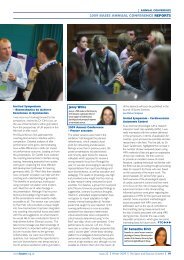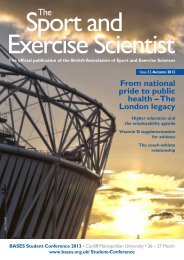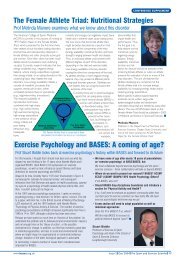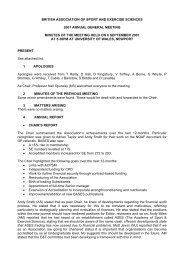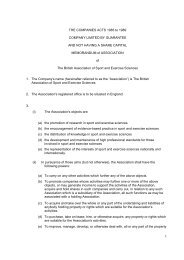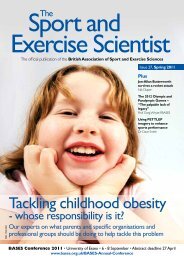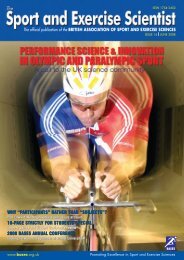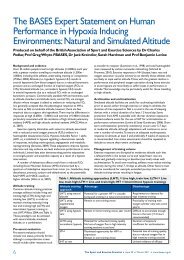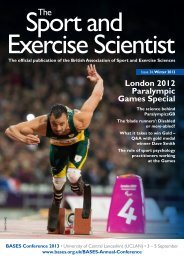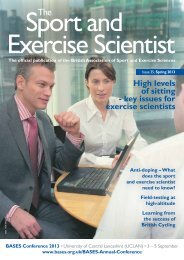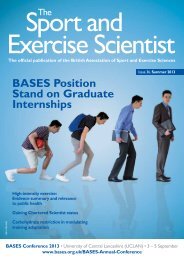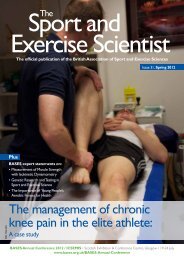Part 2 - BASES
Part 2 - BASES
Part 2 - BASES
You also want an ePaper? Increase the reach of your titles
YUMPU automatically turns print PDFs into web optimized ePapers that Google loves.
COURTESY OF NEIL GIBSONSPORT SCIENCE SUPPORTPhysiological Support – Youth Soccer TournamentsNeil Gibson, Senior Sport Scientist at Heriot-Watt University and Heart of Midlothian FC, reflects on recent experiencePlayers rehydratingduring trainingA great deal is made of the physical demandsfacing professional soccer players required toplay two competitive fixtures per week. For anumber of years, however, youth playershave competed in various tournamentsaround the world, often requiring as many asfive fixtures within a week.This is in stark contrast totheir usual competitiveseason where many willtrain on a part-timebasis and play only onegame per week.However, youthtournaments are a vital partof any young player’sdevelopment, providing valuable competitiveand social experiences. Considering thepotential benefits of participating in such atournament, both staff and players alike mustwork together to ensure everyone gets themost out of their experience.The Milk Cup is an annual tournamentplayed in Northern Ireland at the end of Julyand supported by some of the top clubs inworld football, including Bayern Munich,Everton, Manchester United andFluminense. The following case study willconsider the physical preparation of aprofessional team competing in thetournament. The team is required to playfive 60-minute games made up of two 30-minute periods, Monday through to Friday.Prior to the tournament, only the time,location and opponents of the first twomatches are known to the teams involved.All further fixtures are dependent on results.Preparing for the tournamentFor our squad of young professional players,the Milk Cup falls in the sixth week of preseason,requiring training to be tailored sothat the necessary physical adaptations areachieved without undue fatigue being carriedinto the tournament. To assist in this process,all full-time players are tested within thesports performance laboratory at Heriot-Watt University prior to pre-season for theaccurate calculation of training loads andintensities. This involves a submaximalrunning economy assessment followed bya maximal assessment, both on thetreadmill.‘‘Players can often beresistant to sport science;however, when thesupport staff show anenthusiasm andwillingness to join inthemselves, this certainlyhelps.‘‘Training prior to the tournament consisted offour weeks emphasising physical preparation,team shape, tactics and skill work. The fifthweek was designed as a tapering period withthe emphasis on active recovery. Trainingintensity was monitored through the PolarTeam heart rate system. Administering asuccessful taper requires an excellentrelationship between coach and support staff.The use of physiological data and itspresentation in a useable format in support ofsuch interventions is crucial to the process.Support during the tournamentWith the requirement of optimalperformance in five games over fiveconsecutive days, the need for recoverybecomes paramount. It is generally acceptedthat active recovery and hydrotherapy areconducive to recovery from intense bouts ofexercise. In an attempt to adopt thesepractices, all players who had taken part inthe game were taken through a thoroughcool-down. Getting players back outside afterthey have returned to the changing roomscan be a difficult task, especially if they havelost. As such, we decided to conduct thecool-down immediately following the game,which also gave the coach more time toanalyse the teams performance. To preventthe cool-down adding to post-game glycogendepletion, players were provided with 500ml of isotonic fluids immediately after the finalwhistle.Implementing hydrotherapy strategies with asquad can be problematic at the best of timesand more so when away from its normaltraining base. Following the cool-down,20 l Issue 21 l Sept 2009 l The Sport and Exercise Scientistwww.bases.org.uk
COURTESY OF NEIL GIBSONSPORT SCIENCE SUPPORTPlayers preparingplayers were taken to the beach and into thesea, the water coming up to (at least) theirwaists. Of course, the players weren’t toointerested in the science; their subjectiveanalysis, however, was that it certainly helpedprovide “a freshness to their legs”, as a coachdescribed it. Players can often be resistant tosuch practices, but when the support staffshowed an enthusiasm and willingness to joinin themselves it certainly helped.All players were issued with compressionskins at the start of the season. These wereto be worn after the recovery protocols forat least two hours. The evidence supportingtheir use is equivocal (Duffield & Portus,2007; Doan et al., 2003) however theplayers’ perception was that they certainlyhelped. Research conducted by the VictorianInstitute of Sport in Australia has investigatedthe impact of tournament play, whichcomprised four matches in nine days.Findings suggested that when recoverytreatments are prescribed to players theirsprint capacity is maintained for at least thefirst two matches before a drop inperformance is observed.Training during the tournamentDespite playing a game every day, it is notuncommon for coaches to want to train inthe morning to work on tactics, especially ifthe day’s game is scheduled for an eveningkick-off. In these situations, it is vital to ensurethat players are adequately warmed up priorto training. To this end, players wore heartrate monitors for all training sessions. Datawere used to ensure players were notexceeding 85% maximal heart rate forprolonged periods of time. This level waschosen based on data from their laboratoryassessment and the accompanying lactate andV. 0 2 responses. In-depth knowledge of thetype of drills and respective intensitiesfavoured by the coach is hugely beneficialwhen advising on session design. As such, thesupport team were actively involved in thestructuring of all training sessions. Restingheart rate was taken each morning following5 minutes’ seated rest and compared to dataacquired during laboratory assessments at thestart of pre-season. An increase of 8–10beats in players’ resting levels was used as anindicator that they were not fully recoveredfrom previous exertions. This informationwas used when planning training sessions andalso in team selection. Building a cleardialogue with coaches and working withthem on a day-to-day basis helps putpractices such as this into place, especially instressful environments.HydrationEach morning, players provided a small urinesample for hydration analysis and weresubsequently given an individual drinking planfor the day. Although time consuming, thisproved to be an extremely effective practiceas very few players throughout thetournament showed signs of dehydration.Isotonic fluids were available to the playersbefore, during and after the game to optimiseboth hydration and glycogen uptake. For dayswhen additional training was performed orfor those who struggled to maintain ahydrated state, hypotonic solutions were alsomade available. There is much evidence tosuggest that even slight dehydration canprove detrimental to soccer performance(Edwards et al., 2007), which is magnifiedwhen players are required to play games onconsecutive days. Ensuring each player starts hisor her training session or game both wellfuelled and hydrated is of huge benefit, not onlyto the individual, but to the squad as a whole.In addition to the use of urine osmolalitychecks in the morning, all players wereweighed before and after each game toassess body mass losses during competition.Results were used to direct post-gamedrinking strategies for each individual.Monitoring body mass pre- and postcompetitivesoccer matches has shown to bean effective method of monitoringdehydration due to sweat loss, and providesa simple and cost-effective method (Harveyet al., 2008).Supporting a squad through a tournamentsuch as the Milk Cup is both challenging andrewarding in equal measure. At no other pointin the season does sport science becomemore important for these young players asthey try to optimise performance and shine ina world-renowned competition. ReferencesDoan, B.K. et al. (2003). Evaluation of alower body compression garment. Journal ofSport Sciences, 21, 601–610.Duffield, R. & Portus, M. (2007).Comparison of three different types of fullbodycompression garments on throwing andrepeat-sprint performance in cricket players.British Journal of Sports Medicine, 41,409–414.Edwards, A.M. et al. (2007). Influence ofmoderate dehydration on soccerperformance: physiological responses to 45min of outdoor match-play and the immediatesubsequent performance of sport-specific andmental concentration tests. British Journal ofSports Medicine, 41, 385–391.Harvey, G. et al. (2008). The use of bodymass changes as a practical measure ofdehydration in team sports. Journal of Scienceand Medicine in Sport, 11, 600–603.Neil GibsonNeil is an accreditedphysiologist for applied sportsciencesupport andlaboratory director of Heriot-Watt University’s sportsperformance lab. www.bases.org.ukIssue 21 l Sept 2009 l The Sport and Exercise Scientist l 21
STRICTLY FOR STUDENTSName: Euan HairOccupation/position: Final-year BScHons – Sports Biomedicine Student,University of Dundee.Q What experience did you secure/create alongside, or following, yourstudies?Alongside my studies, I have participated inthree internships provided by the course.These were:1) Sports performance analysis (third year ofdegree).This involved physiological assessment andeducation of elite athletes and spanned allareas of performance. It was a fantasticexperience working with performanceathletes and coaches, and equipped me wellfor presenting data and information in adigestible format.2) Gym internship.This allowed me experience of working withless highly trained people, enlightening me asto the vast rewards people can get fromengaging in an exercise programme. It alsoallowed me to become a qualified personaltrainer and opened my eyes to an alternativecareer route, post-degree.3) Strength coaching internship.The strength coaching internship providedme with invaluable experience and presentedme with an area of sport science that hassince become my passion. I have witnessedhow simple strength training techniques canelicit great improvements in the performanceof athletes, and have obtained valuablecontacts through my work in this area.Outside of university, I approached a strengthand conditioning coach who works withboxers and obtained work experience in hisgym. The most valuable aspect of workingwith someone from a different sport-sciencebackground has been the ability to constantlyquestion techniques and, as a result, myself.Q How did this come about?I secured the sports performance analysisinternship through an application process.However, it is likely that I was selectedbecause I had volunteered to assist withnumerous performance analysis sessionsbefore the internship was established and Ialso tended to pester the lecturers on mycourse to help me further my level ofexperience.The gym internship was also through anapplication process, but this required a Level2 gym instructor certificate. Again, this wassecured by my keen interest. I wouldrecommend any undergraduate to develop agood pestering technique at university, aswithout the experience I obtained throughthese internships, I would have taken a verylimited amount from my university course.The strength coaching internship wasprovided by the university for myself andanother student who also showed a keeninterest. The acquisition of this internshipfurther substantiates how important it is tomake lecturers aware of your interests, as, inmy experience, they will try their best toprovide you with opportunities to developyour knowledge base in specific areas.Q Are there any otherqualifications/CPD/experiences you haveachieved that you feel have wellequipped you for your current position?Following my gym internship, I trained tobecome a qualified personal trainer. Thedifferent experience I gained from eachinternship has helped me develop the serviceI provide to clients. I believe that, bycontinually applying my sport-scienceknowledge, I offer a very different servicefrom the norm, and it is to this that I attributethe number of clients I have acquired.I recently presented my honours project atthe <strong>BASES</strong> Student Conference. I havealways found presenting a daunting prospect,but I thought if I am ever going to get overthis fear of presenting then I have to keepdoing it at every opportunity.Q Are there any difficult decisions youhave had to make on your way togetting where you are?A difficult decision I had to make was toreduce the number of hours that I dedicatedto internships and personal training in my finalyear of my course in order to concentrate onmy studies.This decision has proven beneficial, as evendedicating just a few hours to work andinternships provided me with considerableexperience.Q What advice would you give tostudents starting out and to thosenearing the end of their undergraduatedegrees?The advice I’d give to someone starting theirundergraduate degree is to get stuck in.Opportunities to develop experience arealways available even if they aren’t explicitlypresented. Approach lecturers, local gyms orlocal hospitals and apply for external courses;you will soon find that there is no limit to theexperience that you can obtain. If somethingdoesn’t appeal to your particular interests, stillgive it a go; from my experience, this iswhere I gained my most valuable experience.If you are at the end of your undergraduatedegree, find out as much as you can fromyour lecturers and career advisers about yournext step. They’ve been there so they canreally help you with difficult decisions.Q What is the best piece of advice youhave ever received?I was told by a friend who had already gonethrough my course to “Get stuck in!” It’s asimple piece of advice, which has served mewell so far. Q Any other pertinent qualifications/CPD/experiences youachieved that you feel well equipped you for your currentposition?Supervised Experience was a great opportunity to work on my skillsand abilities which resulted in <strong>BASES</strong> Accreditation which has beenvital for the applied work that I do.Also, presenting at <strong>BASES</strong> conferences provided me withpresentation skills that have been beneficial for interviews, deliveringworkshops and lecturing.Q Any difficult decisions you’ve had to make in the past onyour way to getting where you are?Moving far away from home for my job to a place I knew nothingabout may have been a barrier for some people, but I was excited tohave found a job I was really interested in. I would advise people tojump at opportunities that come their way.Q What advice would you give to students starting out on anundergraduate degree, and to those nearing the end of theirundergraduate?Take on any opportunity available for experience as you never knowwhere it might lead. Also believe in your abilities. Although there arethousands of sports science graduates, think about what can you do toput yourself ahead of the crowd and increase your job chances in thefield. You can do this through enhancing your CV with qualificationsand experience as much as possible, as soon as possible.Q What is the best piece of advice you have ever received?To keep working hard to get a job that I really wanted and not togive up on it after getting some knock backs. It’s so easy to getinvolved in a career that you’re not really suited to because it’s aneasier option, but you need to persevere. If you really want to getthe job of your dreams, you will. www.bases.org.ukIssue 21 l Sept 2009 l The Sport and Exercise Scientist l 23
REVIEWSBook and Resource ReviewsA SNAPSHOT OF SOME OF THE LATEST SPORT AND EXERCISE SCIENCE BOOKSMotor Learning and Performance: A Situation-Based Learning Approach (2008, 4th edition)Authors: Schmidt, R.A. & Wrisberg, C.A. Publisher: Human Kinetics ISBN: 978-0-736-06964-9The scope of this book is to combine a conceptual model of motor performancewith a situation-based learning approach. This model is designed to enable thereader to identify effective responses to a wide range of practical issues in thelearning and performance of motor skills.The text is organised into four comprehensive parts: <strong>Part</strong> one includes an introduction tomotor performance and learning, with specific reference to information processing anddecision making; <strong>Part</strong> two elaborates on the principles of human-skilled performance, such asmovement production, motor programmes, motor control and motor ability; <strong>Part</strong> threediscusses the principles of skill learning and includes information on how to structure a learningexperience and provide feedback; and <strong>Part</strong> four integrates all concepts and principles andattempts to apply them into practical settings.The book is aimed at undergraduate students in physical education, exercise and sportscience, kinesiology, biomechanics, ergonomics, psychology, physical and occupational therapy,and pre-medicine. A supplemental online study guide accompanies the text and is accessiblevia the Human Kinetics website. The content is illustrated with diagrams, key points, casestudies, tables, graphs and photographs, all of which facilitate the understanding of concepts.Each chapter concludes with a set of revision exercises in the form of multiple-choice, “fill inthe gap” and critical thinking questions.The text is suitable for the teaching of motor learning and performance and I wouldrecommend it to academics, practitioners and undergraduate students, as it is exceptionallyinteresting to read and successfully written to address a wide audience. Dr Maria Konstantaki, Buckinghamshire New University10 10Neurophysiological Basis of Movement (2008, 2nd edition)Authors: Latash, M.L. Publisher: Human Kinetics ISBN: 978-0-736-06367-8Any book that recommends a Disney ride as part of the experiential learningprocess has my attention as it illuminates the style and approach of the author,Mark Latash. This is a book that not only informs in great detail and depth, butalso entertains, which is not an easy trick to pull off!It’s also a book that works on several levels; originally conceived as a first-year undergraduatetome, the 2nd edition has been enhanced and could now easily serve for postgraduate work.Latash opines that the 35 chapters could each provide the basis of a lecture, but equally forthe reader, there are easily discernible sections that stand alone and provide an insightfulreference work. The book is organised into six “worlds” starting from the very basis of matter– cells, membranes and particles – and building through connections, structures, behaviours 1and 2, and motor disorders. The complex relationships between neurology and physiology –the muscle spindle receptors through the excitations within the brain and the spinal cord; thesynergistic actions of joints in postural and motor activity; and the effects of fatigue, aging anddisability on locomotion – are all explored in minute detail.Yet it is one of the most readable books in my experience, partly due to the presentation ofthe information whereby the chapters open with a list of key topics and are summarisedsuccinctly at the end. The information is sometimes presented in different formats: there’s anarrative version and, within that, a tabular or schematic version so the learning is reinforced.There is a profusion of diagrams, all supportive of, and relevant to, the material under review.There are self-test problems scattered throughout the chapters, which may be ignored, setaside or taken head-on, though, either way they present an alternative way of looking at, andinto, the material. There are also end-of-section reviews with self-test questions and multiplechoicetests. Finally, there are six heavyweight laboratory projects, each representing aresearch project in its own right (Latash suggests some 18–27 hours of laboratory time intotal).Overriding all this is Latash’s style, which, it has to be said, humanises the driest of scientific data “I suggest that you forget about the engineeringapproach and look at the skeletal muscle optimistically – as a unique design developed by evolution and not as a blunder of nature. In addition topossessing many unique features, muscle is the only edible motor and is delicious when cooked properly.” More seriously, though, he is preparedto acknowledge new information and controversial points of view; his two new chapters (added since the 1st edition) and various scatteredsubsections within the book present current theories of motor control and coordination that leave the reader with the job of assessing theirvalidity. This is an interesting and educative read for sport scientists, movement analysts, biomechanists, physiologists and physiotherapists David Heard, Exercise Physiologist and Chief Executive of The Fitness Consultancy Ltd.10 1024 l Issue 20 l June 2009 l The Sport and Exercise Scientistwww.bases.org.uk
REVIEWSPerformance Assessment for Field Sports (2008)Editors: Carling, C., Reilly, T. & Williams, A.M. Publisher: Routledge ISBN: ISBN: 978-0-415-42685-5This book is written clearly and provides an interesting read intomultidisciplinary performance assessment for field sports. Theintroduction sets the scene nicely about the role and processes ofsport science and this develops into detail of the assessment of motorskills, decision-making skills, match analysis and physiologicalassessments, finishing with a chapter on new technologies.There are no additional resources accompanying the book, although I didn’t feelthat these would particularly add to it. The book would be ideal for someoneworking towards <strong>BASES</strong> Accreditation and gives a good insight into other areasinvolved in performance assessment, rather than concentrating solely onphysiological parameters. Also, at undergraduate level, it would provideknowledge of the basics in each of the areas mentioned above, as well as practicalapplication, to provide an interesting look at the role of a sport scientist.Each chapter provides a good introduction to each area, followed by details ofrelevant performance assessments and practical examples with clear tables anddiagrams that make the resource easy to understand. Evaluations of bothlaboratory and field assessments provide useful recommendations for a variety oftesting options when working with field sports athletes, as teams or individuals,and sport-specific assessment ideas included along the way are also beneficial.Overall, I think the book tackles performance assessment in a clear and conciseway and I would recommend it for those working towards a career in sportscience or those already working in the field, for possible new ideas and to finetunewhat they currently do. Helen Weavers, University of Dundee 8 10Applied Sport Psychology: A Case-based Approach (2009)Editor: Hemmings, B. & Holder, T. Publisher: Wiley-Blackwell ISBN: ISBN: 978-0-47072-574-0This book provides a wide range of case studies of sport psychologyconsultancy experiences. Split into three sections (i.e., working withindividuals, teams and squads, and support staff), the book draws upon thespecific experiences of 12 <strong>BASES</strong> Accredited consultants across a diverserange of sports.The editors have provided a well-thought-through and organised text; each chapterfollows a similar structure by introducing the background to the psychologist’s work withthe chosen client, followed by an overview of initial assessment and interventionprocedures and finishing with an evaluation as to the efficacy of the selected intervention(s)and reflections on their delivery effectiveness. Inherent within each consultancy descriptionis an explanation as to how the scientific literature and consultant’s practical experienceshave guided the initial assessment and intervention choices. I really enjoyed reading thisbook and found that there was something new to learn in each chapter.With a few exceptions, the reference to scientific literature in justifying and reflecting uponeach psychologist’s consultancy choices was both insightful and engaging. Possibly, somechapters could have provided more detail in describing the intervention proceduresemployed; however, the majority offer a real insight into the mechanics of a sportpsychologist’s applied work. Readers new to this discipline (e.g., students, probationarysport psychologists, coaches) will find this book an interesting, thought-provoking anduseful insight into the practical application of sport psychology within the “real world”. Also,for more established practitioners, the case-study approach is likely to provide new ideasfor their applied practice, in addition to stimulating new avenues for further research.In summary, this publication provides a welcome addition to the sport psychologyliterature in moving away from the traditional research/theory/review-style texts anddescribing what applied sport psychologists actually do.Need to Advertise a Job?www.bases.org.uk12,541 Unique views in June 2009To place an advert email jbairstow@bases.org.uk Dr Neil Weston, University of Portsmouth 8 10www.bases.org.ukIssue 21 l Sept 2009 l The Sport and Exercise Scientist l 25
REVIEWSWhat did delegates think of the recent <strong>BASES</strong> Workshops?Using E-learning in Sport and ExerciseSciencePresenters: Jamie Barker, Geoff Walton and Sue LeeSue Lee kicked off the workshop with some interesting insightsinto our current Facebook generation of students, highlightingtheir desire for 'instant gratification' and ability to 'parallel process'information. This nicely set up Jamie Barker and Geoff Walton topresent some innovative work on online collaborative learningwhere students were asked to provide peer feedback on essaywriting through an online 'Blackboard' discussion forum. Inaddition to developing the students' reflection and analytical skills,it developed their IT skills and, most crucially, allowed them tolearn from each other. The consensus among delegates was thatthis style of delivery could be used in all sport science disciplines,not only to assist study skills. John Erskine nicely concluded theday by describing a range of assessment templates that could beused to assess students' contributions to online discussions.All the presenters allowed plenty of opportunities to raisequestions, discuss issues and share experiences and information.The workshop had a nice balance between delivery and practicalactivities to engage the delegates. It presented me with someideas on how to use a virtual learning environment moreeffectively to support student learning and provided a niceopportunity to share ideas about the use of technology inteaching and learning with like-minded peers.Dr Duncan Mascarenhas – Glyndwr UniversityDuncan’sDelegates’Motion AnalysisPresenters: Dr Phil Graham-Smith, Richard Jones,Paul Jones and Dr Paul BriceThis well received and informative workshop was delivered byleading professionals who, between them, were able todemonstrate experiences of working within and beyond academia.Coupled with a genuine interest and passion for furtherdevelopment of the subject area, all participants were bound togain further insight into the field.The workshop consisted almost entirely of practical-based 2D and 3Danalysis, using equipment ranging from your standard home videocamera to a more impressive opto-electronic system. These sessionsundoubtedly provided ideas and methods for all to apply to theirworkplace, regardless of their individual circumstances.While expecting a heavier weighting to be placed on theory, theworkshop’s reliance on practical elements to deliver the sessionprovided good learning opportunities, but those without access tothe specific equipment and/or software might have benefited from amore equal balance in the delivery method.Due to this difference in software, I will not be directly using someof the techniques demonstrated, but undoubtedly many skills learntwill be transferable, as well as thought-provoking.Overall, it was a highly enjoyable workshop that provided insight intothe possibility and opportunity provided by motion-analysis techniquesboth old and new. Presenters were both enthusiastic and approachable.Kevin Drew, Leeds Metropolitan UniversityKevin’sDelegates’rating 7 average rating 9rating 8 average rating 9Health Benefits of Resistance TrainingPresenter: Dr Neil MacFarlaneThe workshop assessed the impact of resistance training from ahealth perspective, but also the presenter highlighted sport-specificexamples where possible. The aspects covered both theapplication and science behind the suggested implementedtechniques, which I felt made the workshop more interesting andof benefit to my desired career path into related research ideas.Delivery of the source material through the use of discussions andlecture-style presentations was exceptional.However, reinforcement of this information through laboratoryprotocols, from a personal point of view, was lacking due to skills Ihad acquired during my degrees, yet other delegates appeared tobenefit greatly from this form of delivery. The workshopcemented previous knowledge I had acquired with additionalinformation being learnt. I am hopeful that the workshop will aidin my applications for PhD research positions within related fieldsand feel that, through the various delivery forms used in theworkshop, this will contribute to any future research applications.Overall, the whole day was exceptional and very enjoyable, madeby Dr MacFarlane’s presentation style. I would stronglyrecommend this workshop to anyone looking to enhance theirunderstanding and knowledge of the benefits that resistancetraining can have.David Hughes, Manchester Metropolitan UniversityDavid’srating9Delegates’average rating926 l Issue 21 l Sept 2009 l The Sport and Exercise Scientistwww.bases.org.uk
COURTESY OF SALLY AKEHURSTCONFERENCE REPORTSelf-love: Understanding theNarcissistic Sport PerformerDr Sally Akehurst reports on research supported by a <strong>BASES</strong> International Travel GrantRecently, I presented some of myresearch at the Nordic Conference:Health, <strong>Part</strong>icipation and Effects ofSport and Exercise at HalmstadUniversity, Sweden. At theconference, I chaired a session titled“To what extent is there reciprocitybetween psychology and sport andexercise science?” I was one of fourpresenters from Aberystwyth UniversityDepartment of Sport and Exercise Science.Specifically, I presented on “Exploringnarcissism: Adoption, application, reciprocityand development from mainstream to sportpsychology”, as well as a research postercommunication titled “Interactive effects ofnarcissism and trait self-consciousness upondispositional choking and the role ofconfidence”, for which I won third prize inthe Young Investigators Award.Narcissism is a personality trait widelyresearched within clinical and socialpsychology and one that is full of intrigue anddebate. The narcissistic personality can existas a clinical personality disorder as defined bythe Diagnostic and Statistical Manual of MentalDisorders (DSM – IV [American PsychiatricAssociation, 1994]), or present itself at a subclinicallevel within “normal functioning”individuals displaying characteristic traits ofnarcissism. The term narcissism derives fromthe Greek myth of Narcissus, a man who fellin love with his own reflection andconsequently perished. Essentially, narcissismrepresents a self-love that is characterised bygrandiosity, self-focus, self-importance andself-absorption, with a lack of empathy andconcern for others (Wallace & Baumeister,2002). There is a wealth of research thatendeavours to unravel the narcissisticpersonality at a clinical and sub-clinical level.From this, an understanding of typicalnarcissistic behaviour and appreciation forcognitive processes can be gathered andexplored within alternative contexts anddomains, to further our awareness andconsideration of narcissistic influence.“Narcissists tend to performbetter in conditions thatprovide greater selfenhancementopportunity.”In their 2002 study, Wallace and Baumeisterexplored the rises and falls of narcissists’performance with perceived opportunity forglory and particularly highlighted therelevance of narcissism for performance.They found that narcissists performed betterin all conditions that provided greater selfenhancementopportunity. Across fourstudies, including various tasks andmanipulations of self-enhancement,narcissists were found to increase theirperformance under conditions of highchallenge, high pressure, and publicevaluation, in comparison to participants oflow narcissism revealing little change inperformance between conditions. Further tothis, Wallace et al. (2005) discussednarcissism as a potential moderator of therelationship between audience support andsport performance. The very apparentsignificance of narcissism and its potential toinfluence performance under pressurestimulated my interest within the realms ofmy broader research area of “choking underpressure”, and has formed a salient researchfocus of mine and my previous supervisorsand colleagues, Dr Tim Woodman and ProfLew Hardy of Bangor University.Specifically, our research examines thepotentially moderating role of narcissismwithin sport performance. Much researchhas tested and attempted to explain theeffects of pressure on performance withinsport, and explored a number of variablesthat are thought to impact on performanceoutcome; for example, anxiety, effort andconfidence (Woodman & Hardy, 2001). Theterm “pressure” is used here to encompassall situations in which there is a perceivedimportance for performing well (Baumeister,1984). However, recent recommendationssuggest that further consideration ofindividual differences is necessary for us togain greater understanding of themechanisms by which performance canexcel or decline under pressure (Beilock &Gray, 2007). On this basis, it seems intuitivethat narcissism presents itself as a keyvariable to explore in relation toperformance under pressure and,furthermore, its relationship with otherindividual difference variables.It is argued that sport presents itself as a richcontext within which to explore thenarcissistic personality and further ourunderstanding of the cognitive andbehavioural processes that underpin eliteperformance. Obviously, with the focus onsub-clinical narcissism, sport provides a stageupon which opportunity for glory, publicevaluation, admiration from others,exhibitionism, demonstration of ability andfocus of others’ attention can be fostered toextreme levels and exploited in a potentiallyacceptable manner. It would seemreasonable to expect a performer with highnarcissistic characteristics to differ from aperformer of low narcissistic tendencies intheir cognitive approach and resultantbehaviour within sport. With regard to theapplicability of this line of research (althoughthere is a long way to go until there issubstantial and consistent evidence toprovide a platform for appliedrecommendations to sport psychologists,coaches, and athletes), it is proposed thatfuture research is needed.Our research to date supports theseinclinations and, furthermore, the interestand intrigue with which conferencedelegates conversed with me regarding mysymposium presentation and researchposter, suggested support for the relevanceand worthiness of exploring narcissism insport. ReferencesAmerican Psychiatric Association. (1994).Diagnostic and Statistical Manual of Mental Disorders (4thedition). Washington DC: American Psychiatric Publishing, Inc.Baumeister, R.F. (1984). Choking under pressure:Self-consciousness and paradoxical effects of incentives onskillful performance. Journal of Personality and SocialPsychology, 46, 610–620.Beilock, S. L. & Gray, R. (2007). Why do athletes“choke” under pressure? In Handbook of Sport Psychology(3rd edition) (edited by G. Tenenbaum and R.C. Eklund) pp.425–444. Hoboken, NJ: John Wiley & Sons.Wallace, H.M. & Baumeister, R.F. (2002). Theperformance of narcissists rises and falls with perceivedopportunity for glory. Journal of Personality and SocialPsychology, 82, 819–834.Wallace, H.M. et al. (2005). Audience support andchoking under pressure: A home disadvantage? Journal ofSports Sciences, 23, 429–438.Woodman, T. & Hardy, L. (2001). Stress andanxiety. In Handbook of Sport Psychology (2nd edition)(edited by R.N. Singer, H.A. Hausenblas and C.M. Janelle),pp. 550–565, Chichester: Wiley.Dr Sally AkehurstSally is a lecturer insport and exercisepsychology atAberystwyth UniversityDepartment of Sport andExercise Science and a<strong>BASES</strong> Accredited Sportand Exercise Scientist(Psychology – ScientificSupport).www.bases.org.ukIssue 21 l Sept 2009 l The Sport and Exercise Scientist l 27
WORKSHOPS<strong>BASES</strong> Winter Workshop Programme 2009KinanthropometryFriday 11/Saturday 12 September, 5.30–9.15pmand 9.00am – 5.30pm @ Liverpool John Moores UniversityProf Roger EstonThis workshop will consider methods of body composition analysis, fromcadaver analysis, DEXA, underwater weighing to bioelectrical impedanceand skinfold thicknesses. The programme is biased towards hands-onexperience with a range of practical tasks.Acute Exercise and Psychological Outcomes: Conceptsand research methods and translational implicationsfor clinicians, practitioners and researchers(REPs points available)Thursday 24 – Friday 25 September, 6–8pmand 9.15am – 4.30pm @ University of ExeterProf Adrian Taylor, Prof Gaynor Parfitt, Panteleimon ‘Paddy’ Ekkekakisand Dr Susan BackhouseThe purpose of this workshop is to draw together the experiences of someof the leading researchers on the acute effects of exercise to provideguidance on contemporary study design, identify emerging and priorityissues for researchers, and clarify the practical implications. Laboratoryexperiences will be supported by keynote lectures and small group tutorials.Exercise for Cancer Patients and SurvivorsSaturday 3 October, 9.30am – 4.30pm @ Middlesex UniversityOR Tuesday 17 November, 9.30am – 4.30pm @ Glasgow UniversityDr Anna CampbellThis workshop is the first in the UK to provide information on the benefits ofexercise-based cancer rehabilitation. It will cover introductory information oncancer – the different types, treatments, medications and side effects.Statistical information on cancer survivorship and the evidence-basedbenefits of exercise during and after treatment will be described in detail.This new area of research and the development of current guidelines will bediscussed. The workshop will provide standard recommendations for cancersurvivors post-treatment.Putting Theory into Applied Practice: Supportingathletes and coachesMonday 9 November, 9.30am – 4.30pm @ University of BathJonathan RobinsonThe workshop will aim to provide delegates with the essential vocationalskills required to work in an applied sport science support setting, whilealso introducing some of the physiological competencies required for<strong>BASES</strong> Supervised Experience and Accreditation. Seminars will encompassthe support process from planning through to assessment, interpretation andfeedback to coaches/athletes, alongside the presentation of case studies asleading examples of our support work with elite athletes.Applied Physiological Support to the HighPerformance AthleteSaturday 21 November, 9.30am – 4.00pm @ Loughborough UniversityPhysiological support has evolved from an applied research and testingservice to a focused performance-enhancing service. From both linearand non-linear sports, this workshop will draw upon extensive andcontemporary experience of those charged with providing physiologicalsupport to Olympic athletes. The workshop acknowledges the need forpractitioners to develop a sense of perspective about their work, whileunderstanding the pertinent and detailed demands of the sport. Engagingand integrating into a coach and athlete’s lives is explored, andpresenters will be asked to look forward to how the boundaries ofphysiological support can be moved forward in the coming years.Dr Steve Ingham, Dr Jamie Pringle, Dr David Bailey & Dr Barry FudgeInto the Fire: Preparation for working at a majorevent as a sport psychologist(in association with the British Psychological Society)Wednesday 25 November, 9.15am – 4.45pm@ University of SalfordDr Tom Fawcett, Dr Jonathan Katz & Katherine BondThis workshop will explore the role of the sport psychologist within amajor tournament/championship experience. It will be ‘experiential’, inthat the material will be presented in interactive mode with ‘real’ sharedexperiences from presenters informing discussion groups, case studies,problem-solving tasks, reflective practice and short informativepresentations, requiring active involvement from delegates. It will coveressential themes that all presenters will bring to the session from their priormajor games/championship experiences. If you are a newly qualifiedsport psychologist or at the end of your Supervised Experience, then thisworkshop will benefit you considerably.Undergraduate Dissertation/Project Work:A perspective from two UK institutions(in association with the Higher Education Academy Network for Hospitality, Leisure, Sport and Tourism)Weds 21 October, 9.30am – 4.00pm@ University of Wales Institute, CardiffDr Richard Tong, Dr Owen Thomas and Dr Alison PurvisThe increasing number of students undertaking sport-related degreeprogrammes places a series of demands on faculties/schools that stilloffer an undergraduate dissertation/project as a study mode. Thisworkshop aims to share experiences and examples of practice from twouniversities undertaking such learning experiences. The workshop isspecifically designed as an interactive forum where all attendees andpresenters can share information on aspects of best practice that may insome way contribute to improving delivery at their home institution.Welcome to the Jungle: Getting started in appliedsport and exercise psychologyWednesday 4 November, 9.15am – 4.15pm @ University of ChesterDr Chris Harwood, Dr Ross Roberts, Xavier Sanchez and Dr David TodThe key objective of the workshop is to help people develop skills andknowledge on how to successfully begin and complete SupervisedExperience, and optimise professional development during the SupervisedExperience process.The Application of Biomechanics and PerformanceAnalysis in Strength and ConditioningWednesday 2 December, 9.30am – 4.30pm @ University of SalfordDr Phil Graham-Smith, Paul Jones, Paul Comfort, Martyn MatthewsThis workshop is designed for biomechanists, performance analysts andstrength and conditioning specialists who want to gain a practicalunderstanding of the application of biomechanical techniques in astrength and conditioning context. The workshop will focus on movementspecificity and consider issues relating to testing protocols and theexecution of drills. Delegates will be encouraged to participate in crossdisciplinediscussions and reflect on the extent to which they couldMeasurement of Muscle Strength and Joint Functionusing Isokinetic DynamometersWednesday 16 December, 9.30am – 4.15pm@ Manchester Metropolitan UniversityProf Vasilios Baltzopoulos, Dr Nigel Gleeson and Dr Neil ReevesThe assessment of muscle strength by measuring the joint moment usingisokinetic dynamometry is affected by a number of mechanical andneuromuscular factors. Understanding the effects of these factors on thereliability and validity of dynamometry parameters is essential for thecorrect interpretation of muscle strength and joint function measurementsand their relationship to performance.For further details and/or to book a place go to www.bases.org.uk or phone 0113 812 6163/6228 l Issue 21 l Sept 2009 l The Sport and Exercise Scientistwww.bases.org.uk
Five books thatinfluenced me...Prof Jim Watkins, Swansea University, was asked to list fivebooks and explain why he considers them to have influencedhis development as a sport and exercise scientist.“The Mechanics ofAthletics”by Geoffrey Dyson (1962)In the UK, biomechanics wasintroduced into the curriculum ofphysical education (PE) degreecourses in the early 1970s. Sportscience emerged as a degreesubject around 1976. Like manyothers of my generation, my firstreal exposure to biomechanics wasas an elective module in apostgraduate taught Masters degreein PE, and at that time there werevery few refereed journals andbooks concerned with thebiomechanics of movement in PEand sport. However, ifbiomechanics had been taught, thenDyson’s book would probably havebeen at the top of the reading list. Itwas way ahead of its time in termsof content (relevance) andpresentation (illustrations). AlthoughDyson’s book is mainly concernedwith track and field athletics, it alsodevelops understanding ofbiomechanical principles and, assuch, is as relevant today as it waswhen first published.“Animal Mechanics”by Roy Porter (1999)Like Dyson’s book, this wasintroduced to me during myMasters course. Whereas Dysondescribes the mechanical principlesunderlying track and fieldmovements, Alexanderdescribes thebiomechanics ofbiological tissues and,in particular, the waythat the growth anddevelopment of allliving organisms arestrongly influenced bymechanical loading.“The Mechanicsof HumanMovement”by Bernard Hopper(1973)While Dyson’s book focuses ontrack and field movements,Hopper’s book is concerned withhuman movement in general and,like Dyson’s, Hopper’s approach isto progressively develop knowledgeand understanding of mechanicalprinciples and then demonstrate theapplication of these principles inwell-illustrated and highly relevantexamples.“The Coordination andRegulation ofMovements”by Nicholas Bernstein, Englishtranslation from Russian (1967)Another book from mypostgraduate taught Masters PEcourse. Our understanding of themechanisms underlying thecoordination of human movement(the timing of relative motionbetween body segments) hasincreased considerably in recentyears, due, in part, to considerabletechnological advances that allowrapid determination of muscleforces and joint torques. LikeDyson, with track and fieldbiomechanics, Bernstein was wayahead of his time in hisunderstanding of the mechanismsunderlying the development ofcoordination in all animals. Therecently established dynamicsystems approach to thedevelopment of coordination owesmuch to the ideas of Bernstein.“Biomechanics of HumanMovement”by David Winter (1979)This book is one ofthe best (some wouldsay the best) onbiomechanical analysisprocedures. Theresource describesthe procedures formeasuring thekinetics of muscleactivity and theresulting kinematicsof movement. Thebook is now in its4th edition;although since its 2nd edition, itstitle has been “Biomechanics andMotor Control of HumanMovement”, which preciselydescribes the content. FORTHCOMING EVENTSCalendar of EventsSOME KEY EVENTS TO WATCH OUT FORSEPTEMBER 20091-3 <strong>BASES</strong> Annual ConferenceLeeds Metropolitan Universitywww.bases.org.uk/<strong>BASES</strong>-Annual-Conferencei1-4 BUCS Conference, Trade Fair and BallKeele Universitywww.bucs.org.uk/conferencei6-8 Epithelia & Membrane Transport Themed Meetingwith a focused symposium on 'Epithelial form,function and transportNewcastlewww.physoc.org/meetingsi11 Vetting and barring scheme - safeguardingchildren and vulnerable adults in sportLoughborough Universitywww.isrm.co.uki9-13 Joint International Meeting - Woods Hole USA,with the Society of General Physiologists,including a focused symposium on 'Basic biologyand disease of muscle'.Woods Hole, USAwww.physoc.org/meetingsi13-17 BASEM Clinical Skills Course 2009Bisham Abbey National Sports Centre, Marlow, Buckswww.basem.co.uki16 Researching Youth Sport: SupportingYouth Ability and TalentBrunel University, Uxbridgewww.brunel.ac.uk/rys2009i22-24 Leisure Industry WeekNEC, Birminghamwww.liw.co.ukiOCTOBER 20095-6 National Obesity Conference - Time To Get Serious!The Royal College of Physicians, Londonwww.nof.uk.comi7,8,9 BASEM Annual Congress 2009Barceló Carlton Hotel, Edinburghwww.basem.co.uki21 Environment, Well Being & Healthy Lifestyle 2009Moat House Hotel, Stoke on Trentwww.bw-stokeontrentmoathouse.co.ukiNOVEMBER 20095-7 Annual Conference of the Canadian Society forPsychomotor Learning and Sport PsychologyToronto, Ontario, Canadawww.scapps.orgiDECEMBER 200914-16 Cellular & Integrative Neuroscience ThemedMeeting with a focused symposium on 'Sensoryprocessing: From transduction to behaviour'.Cardiffwww.physoc.org/meetingsiwww.bases.org.ukIssue 21 l Sept 2009 l The Sport and Exercise Scientist l 29
<strong>BASES</strong> Leeds Metropolitan University, Carnegie Faculty of Sport & Education, Fairfax Hall, Headingley Campus, Beckett Park, Leeds LS6 3QS
<strong>BASES</strong> CONTACTSJune 2009 <strong>BASES</strong> InternationalTravel Grant Award WinnersLead AuthorDr Michael Graham(Newman University)ConferenceThe XXIVth International Symposiumon Cerebral Blood Flow, Metabolismand Function/The IXth InternationalConference on Quantification ofBrain Function with PETTitle of the abstractEvidence for brain trauma following fivetwo-minute rounds in boxing.Dr Mark Wilson(University of Exeter)4th International Conference onSpatial CognitionAttentional control, anxiety and faraimingperformance: Re-examining thelocation suppression hypothesis.Dr Siobhan Strike(Roehampton University)International Society of Biomechanicsin SportMechanics of amputee jumping – jointwork.Dr C Douglas Thake(Coventry University)13th International Conference onEnvironmental Ergonomics (ICEE2009)Applications for travel grants for conferences between Apriland June 2010need to be submitted by 1 March 2010.Contact Jane Bairstow on jbairstow@bases.org.uk1. The effect of heat acclimation onthermal strain during ExplosivesOrdnance Disposal (EOD)-related activityin moderate and hot conditions.2. A thermal physiological comparisonbetween two Explosives OrdnanceDisposal (EOD) suits during work-relatedactivities in moderate and hot conditions.3. Physiological, perceptual and cognitiveresponses to conducting nucleardecommissioning-related activities whenwearing a pressurised breathing air suit(PBAS) in moderate and hot conditions.<strong>BASES</strong> Office StaffJane Bairstow, Office Managerjbairstow@bases.org.uk (All other enquiries).Tel: 0113 812 6162Kate Yule, Education Officerkyule@bases.org.uk Tel: 0113 8126165Marsha Stankler, Administrative Assistantmstankler@bases.org.uk (Workshops)(Mon–Thurs only) Tel: 0113 812 6163Jane Gillott, Administrative Assistantjgillott@bases.org.uk (Membership)(Tues & Thurs only) Tel: 0113 812 6164The <strong>BASES</strong> BoardChair | Prof Jo Doust - j.h.doust@brighton.ac.uk<strong>BASES</strong> Executive Officer | Debbie Pearce -dpearce@bases.org.ukDivisional Chair of Physical Activity for Health | Dr Jason Gill -j.gill@bio.gla.ac.ukDivisional Chair of Sport and Performance | Dr Ken VanSomeren - ken.vansomeren@eis2win.co.ukDivisional Chair of Education and Professional Development |Dr Martin Sellens - sellm@essex.ac.ukNon-Executive Directors | Graham Wilson and Sue AnstissFilling a job vacancy?The <strong>BASES</strong> website offers an idealplace to advertise sport andexercise science related jobvacancies to a highly targetedaudience.For more information visit www.bases.org.ukJob AdvertsAdvertising on the <strong>BASES</strong> jobspage costs:£300 + VAT (15%) for one job ad.£400 + VAT (15%) for two job ads£500 + VAT (15%) for three ormore job advertisements.To place a job advertisement simplysubmit job details online via our simpleform or e-mail jbairstow@bases.org.ukStudentshipsThe service is free and aims to provide avaluable service to institutions and sportand exercise science graduates. Pleasenote that research assistantships andresearch fellowships (i.e., salaried posts)are not eligible for the <strong>BASES</strong> studentshippage. Such positions can be advertisedon the <strong>BASES</strong> jobs page.For more information visit www.bases.org.ukThe British Association of Sport and Exercise SciencesLeeds Metropolitan University, Carnegie Faculty of Sport and Education,Fairfax Hall, Headingley Campus, Beckett Park, Leeds LS6 3QTTel/Fax: 0113 812 6162www.bases.org.uk Issue 21 l Sept 2009 l The Sport and Exercise Scientist l 31



